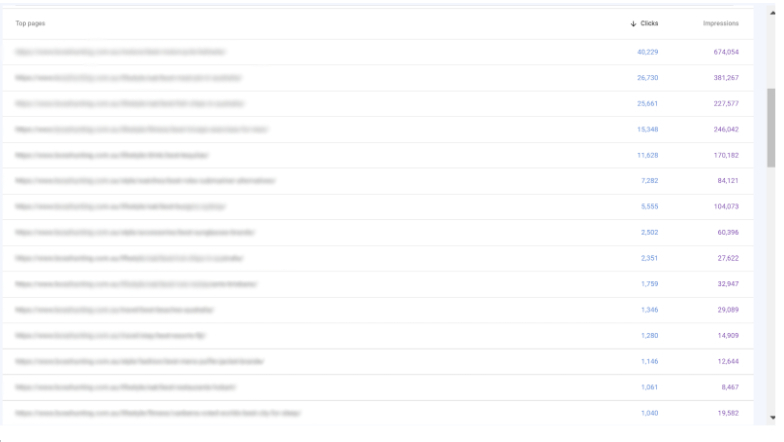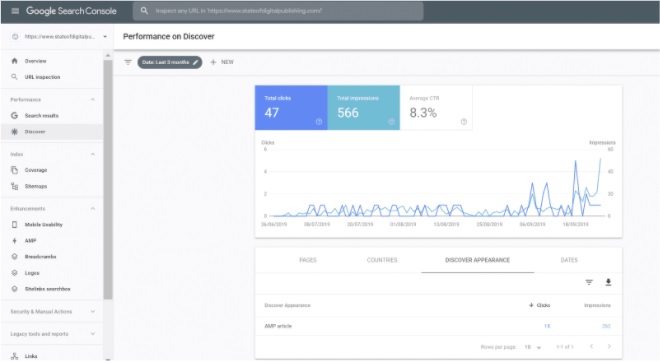Google Discover was introduced in 2018 with the goal of changing how the search giant’s users interact with content.1
Discover’s launch was, in effect, a rebranding of the Google feed that was introduced the previous year. Google described Discover as providing two main functions; keep users up-to-date and provide recommendations when they are not actively searching.
It is one part of the company’s larger strategy of moving away from a narrow search-based focus and embracing a more detailed analysis of the user journey.
The predictive aspect of Google Discover is one of its key features. It provides a glimpse into a future where AI assistants will be able to give the user what they want without the need for a traditional search.
And while, particularly in its early stages, Google Discover has the ability to increase a publisher’s site visibility and drive organic traffic, constant algorithm changes have caused frustration for sites looking to appear in the Google Discover feed.
Therefore, staying at the forefront of SEO practices is imperative for news sites looking to take advantage of this Google feature.
Table of Contents
What is Google Discover?
Google Discover is a personalized content recommendation engine for mobile devices that is powered by AI and is based on a user’s search history and online behavior. On the Discover feed, fresh content and evergreen content is displayed based on a user’s interests.2
When the user navigates to the Google or Google Chrome app on their phone or tablet, Discover content appears immediately below the search bar. It does not appear in other mobile browsers.
Google can even predict a reader’s level of expertise in each topic to ensure that the new content they serve is of use to them.
According to Google, relevant content is automatically eligible to appear in Discover if it is indexed by Google and meets Discover’s content policies.3
 How Does Google Discover Affect SEO?
How Does Google Discover Affect SEO?
While most news sites and businesses understand the importance of SEO on a broader level, many are still not placing as much emphasis on optimizing for the Google Discover feed as they should.
As with Google News Top Stories,4 Google Discover is an integral part of SEO as it is inextricably linked to Google Search and what is shown to users.
The user has a high level of control over what they see in Discover. They can follow specific topics and tell Google when they want to see more or less of any particular subject according to their interests.
One key aspect of the content Discover displays is that the focus is not on newly published content but on material that is new to the user, even though it may have been published a year ago.
Why Google Discover is the Future of Search
Content recommendation engines are used by all kinds of online media companies and services — think of the YouTube home feed and Netflix’s own suggestion-based approach to viewing — to keep users engaged and increase the time spent on their services.
In August 2021, Google Discover started surfacing “Short videos”5 alongside web pages, regular videos and, later, AMP-based Web Stories.6
In the past, online media and services were passive providers. They showed us what they had and reacted only when users asked for more: we searched, navigated, explored. Now online media and services are taking a proactive approach in serving users new content.

Google Discover represents another step in that trend, one that could change how content is optimized and keyword research is conducted. SEO today is built around Google Search. What are people searching for, what is their intent, and how can we answer it in a way that Google will see as relevant?
Ben Gomes, SVP for Search, News, and Assistant at Google, has shared three shifts in its approach to search:7
- The shift from answers to journeys. An answer is a final point, without continuity. Google wants to anticipate the user’s next question. Where are you in your learning journey? What will you need to know next? Google now sees an answer as one step in the user’s ongoing need for information.
- The shift to providing query-less information. Google Discover is the key element of this shift as it doesn’t rely on search queries and instead proactively shows relevant, behavior-based content.
- The shift from text to visual-based information. This is about more than just surfacing more images and videos on a search engine results page (SERP). Google wants to facilitate the creation of more visual content through Google Web Stories. Besides that, new tools like Google Lens enable people to use picture segments — from Google Images for example — as search queries.
Content discovery, as opposed to traditional search, is becoming more important for Google. This doesn’t mean that SEO is dead, just that the SEO community needs to adapt to a new reality.
How to Optimize Content for Google Discover
Focus on Quality and User Benefit
Google’s AI picks the content appearing in Discover that it deems will fulfill a user’s perceived information need or interest. Google will then ensure that only top-quality content is featured on Discover.

The most important tip for publishers is to create content relevant to their specific audience, whether it’s a local community or organized around a particular topic. Publishers can use the Google Discover Insights tool to publish content that works for their brand and aligns with their readers’ interests.8Create Catchy Titles
All good writers and content creators know the importance of creating a catchy headline that piques the reader’s interest. However, Google has fairly strict guidelines regarding clickbait and misleading content, and 2022 has already seen several documented cases of news publishers receiving specific Google News and Google Discover manual actions.9

Writers can start by creating a short but sweet title that accurately captures the nature of the article and then ensure that they are meeting the following Google Discover guidelines:10
- Avoid tactics to artificially inflate engagement. This can either be through the use of misleading or exaggerated details in preview content — title, snippets or images — or by withholding information crucial to understanding what the content is about.
- Avoid tactics that manipulate appeal by catering to morbid curiosity, titillation or outrage.
Build Relationships and Trust With Audiences
While Google has said its rankings algorithm is not influenced by social media signals,11 research from 2018 showed that raising brand exposure across social platforms can influence rankings on Google properties.12
This means that a promotional and content distribution strategy can still have a significant impact on making content attractive for Google Discover.
That doesn’t mean putting all content on social media, rather be strategic around content promotion efforts.
Google also uses content engagement from search and other channels — like email newsletters — to determine brand trustworthiness. Not just the traffic the content receives, but how the audience engages with the content: how much time they spend on a site, how many articles they visit, and how frequently they visit that site.
Google also rolled out a Follow feature that allows users to follow and receive the latest updates from a website within Discover.13 The Follow button is presently an experimental feature, only available to some English users in the US using Chrome Android Beta.14

The Follow feature currently uses either the RSS and Atom feeds on a website or — for those without these feeds — Google will automatically generate a feed for an entire domain. Site owners who want to optimize the Follow experience can add the below code to their pages.14Use Images and Video
One of the shifts Google is taking in its approach to search is to give more weight to visual content. Creating compelling images and video content on a page will give a publisher more chances to be picked up by Google Discover.

Google advocates for the use of “compelling, high-quality images” that are at least 1200px wide, as these are “more likely to generate visits from Discover”.14Create a Mix of New and Evergreen Content
While Google feed mostly surfaced trending content, Discover takes a user-first approach. Google wants to provide the user with the content they want or need at that point in their knowledge journey.
And that means the Discover feed will show the latest industry news or a long-form piece about a specific issue that’s still relevant even though it might have been published one year earlier.
Your content strategy for Discovery should reflect that approach and include current events and evergreen content.15
Below is a list of top performing “best listicles” from one of State of Digital Publishing’s clients, as generated by Google Search Consoles’ (GSC) Discover report.


Prior to the article’s refresh, the article was attracting slightly more than 1,000 clicks per month over the preceding three-month period. After the client implemented the SODP team’s analysis and a content strategy, the article quickly began attracting more than 10,000 clicks per month.
Follow Google News Content Policies
Google says that content needs to adhere to the Google News content guidelines to be featured in Google Discover’s cards.16 This doesn’t mean that the content needs to be in Google News, or that the content will be in Google News if it’s on Discover or vice-versa.
The only implication is that content featured in Discover could also be eligible for inclusion in Google News. In this sense, Google News SEO and Discover SEO are indelibly linked and should both be considered as part of a publisher’s broader SEO strategy when publishing content.17
Apply Metadata to Content
Google Discover uses machine learning to organize content and make decisions on which content to recommend for each user.
Implementing metadata (special tags) on Google Discover content helps Google’s AI to understand what that content is about and the informational gap it covers.
How to Analyze the Impact of Google Discover on Organic Traffic
Google Search Console (GSC) has a specific section covering which content was picked up by Google Discover and its performance on the search engine.
Available to publishers who already have content on Google Discover,
the Discover Performance Report displays impressions and CTR, as well as a clicks timeline and the countries from which the traffic originated.18

But what if a site owner wants to analyze traffic data in Google Analytics or any other web analytics suite?
Previously there was no clear way to attribute traffic to Google Discover in Google Analytics, with publishers having to use roundabout methods to analyze their Discover traffic.
However, in late 2021, Google Analytics started to show results for Discover traffic, which was most likely the result of Google News Showcase attaching UTM-parameters to the URLs.
Publishers can start accessing these metrics by navigating to Google Analytics and checking their acquisition, source and medium traffic, where they may see [newsshowcase / discover] in the list.
Content from our partners

To understand how Discover works for them, publishers can start by grouping the content featured on Discover by topic and, if possible, subtopic. It will help deliver some initial insights into the type of content that is picked up by Discover and how effective it is.
From that baseline, they can start experimenting with different headline styles and different types of images and see what helps improve visibility and engagement on mobile web browsers.
However, it should be noted that from SODP’s experience of using Google Analytics to monitor client traffic, a good portion of web page referrals that could be classed as from Discover is still branded as direct traffic and not yet 100% accurate.
Google doesn’t properly attribute referrers across various platforms and it is often the case that different sources of referrals could be constituted as Google Discover traffic.
Valentin Pletzer addressed the issue of trying to track visits from Google Discover a few years ago, and mapped out his findings in the table below:19
| iOS | full referrerwith filter |
|---|---|
| Google App (Discover) | no referrer(direct) |
| Google App (Search) | https://www.google.com/search?q=…. (not cut)www.google.com/ |
| Google News App | https://news.google.com/news.google.com/ |
| Google Chrome (Articles for you) | https://www.googleapis.com/auth/chrome-content-suggestionswww.googleapis.com/ |
| Google Chrome (Search) | https://www.google.com/www.google.com/ |
| Android | full referrerwith filter |
|---|---|
| Google App (Discover) | https://www.google.com (no trailing slash)www.google.com |
| Android Floating Search Bar | https://www.google.com (no trailing slash)www.google.com |
| Android Google Chrome (Search) | https://www.google.com/www.google.com/ |
| Android Google Chrome (Articles for you) | https://www.googleapis.com/auth/chrome-content-suggestionswww.googleapis.com/ |
| Android Google News Widget | https://news.google.com/news.google.com/ |
| Android 9 | full referrerwith filter |
|---|---|
| Google App (Discover) | android-app://com.google.android.googlequicksearchbox/https/www.google.comcom.google.android.googlequicksearchbox/ |
| Google App (Search) | android-app://com.google.android.googlequicksearchbox (no trailing slash)com.google.android.googlequicksearchbox |
| Floating Search Bar | android-app://com.google.android.googlequicksearchbox (no trailing slash)com.google.android.googlequicksearchbox |
Diagnosing Discover Traffic Drops
While the Google team is still working on providing many publishers with accurate Discover analytics for their sites, there are still ways site owners can diagnose drops in their Discover traffic.
Some publishers have reported seeing sudden drop-offs in Discover traffic.20 This can be due to several things, including Google core updates, algorithm changes or manual actions.
Manual actions are issued to a site by Google when a human reviewer deems it does not meet Google’s webmaster quality guidelines.
There are a range of reasons a site can be issued a manual action, from misleading conduct to user-generated spam to keyword stuffing.
Google Search Console (GSC) provides an easy way to see whether a site has received any manual actions via the manual actions report.21
Publishers who have received a manual action can, and should, amend the problem immediately by following Google’s advice.
Conclusion
Google Discover represents a significant shift in how Google approaches its mission of organizing information and providing users with the best and most useful content.
This shift reflects a change in user habits, which have seen us become so used to recommendation engines that these AI-powered discovery mechanisms are responsible for a huge part of our media consumption.
It makes sense for Google to introduce content discovery as a tool to keep us engaged with their ecosystem.
For publishers, it makes sense to be on top of a trend that could change the shape of search optimization forever and presents an opportunity for their content to be exposed to a new audience.
- Introducing Google Discover: Discover new information and inspiration with Search, no query required
- Customize what you find in Discover – Android – Google Search Help
- Discover content policies – Google Search Help
- Google Top Stories Carousel – State of Digital Publishing
- Google Discover surfacing YouTube in ‘Short videos’ carousel – 9to5Google
- Creating Google Web Stories: A Best Practice Guide for Publishers – State of Digital Publishing
- Improving Search for the next 20 years
- Google Discover Insights – SEO tools – Alekseo
- https://twitter.com/glenngabe/status/1487834513996754948
- Get on Discover | Google Search Central | Documentation
- Are pages from social media sites ranked differently?
- Does Social Media Impact SEO? We Ran an Experiment to Find Out
- Chromium Blog: An experiment in helping users and web publishers create deeper connections on Chrome
- Get on Discover | Google Search Central | Documentation.
- What Is Evergreen Content? – State of Digital Publishing
- Google News policies – Publisher Center Help
- The Ultimate Guide to Google News SEO – State of Digital Publishing
- Performance report (Discover) – Search Console Help
- How to track Google Discover in real-time
- Google Discover Traffic has dropped by 90% since December Core update
- Manual Actions report – Search Console Help



 How Does Google Discover Affect SEO?
How Does Google Discover Affect SEO?








